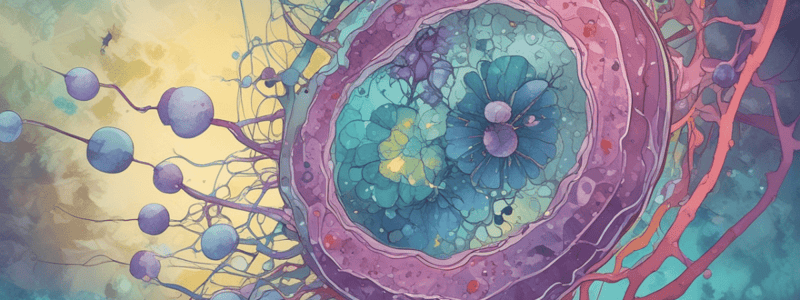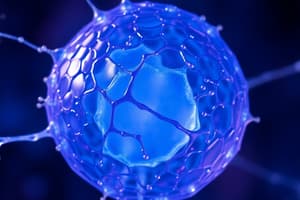Podcast
Questions and Answers
What are the two main outcomes of cell differentiation?
What are the two main outcomes of cell differentiation?
Different appearance and structure, Functional specialization
What is the function of the nucleus in a cell?
What is the function of the nucleus in a cell?
Stores the genetic material, Coordinates all cell activities, Molecular machinery
Which of the following components make up the nuclear envelope?
Which of the following components make up the nuclear envelope?
- Perinuclear space (correct)
- Inner membrane (correct)
- Outer membrane (correct)
- Nuclear pores
Chromatin is composed of DNA.
Chromatin is composed of DNA.
Flashcards are hidden until you start studying
Study Notes
Cytology 1
- There are two main types of cells: prokaryotic cells and eukaryotic cells (human cells).
- Prokaryotic cells are unicellular, have no nucleus, and no organelles.
- Eukaryotic cells are multicellular, form tissues, have a nucleus, and have organelles.
- Eukaryotic cells undergo differentiation, which involves the interaction between genes and microenvironment, leading to two main outcomes: different appearance and structure, and functional specialization.
Nucleus
- The nucleus is the command center of the cell.
- It stores the genetic material, coordinates all cell activities (growth, metabolism, protein synthesis, cell division), and has molecular machinery.
- The nucleus has four components: nuclear envelope, nuclear pores, nucleoplasm, and chromatin.
- The nuclear envelope has two membranes (inner and outer) and a perinuclear space.
- Nuclear pores regulate the movement of ions and small molecules between the nucleoplasm and cytoplasm.
- Nucleoplasm, also known as karyoplasm, is a viscous fluid.
- Chromatin is made up of DNA, with 46 chromosomes in human cells (22 pairs of autosomes in somatic cells, and 22 autosomes in gametes).
Studying That Suits You
Use AI to generate personalized quizzes and flashcards to suit your learning preferences.




